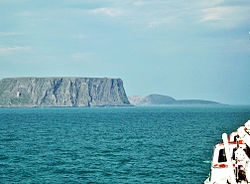Cape (geography)
Large headland extending into a body of water, usually the sea From Wikipedia, the free encyclopedia
In geography, a cape is a headland, peninsula or promontory extending into a body of water, usually a sea.[1] A cape usually represents a marked change in trend of the coastline,[2] often making them important landmarks in sea navigation. This also makes them prone to natural forms of erosion, mainly tidal actions, resulting in a relatively short geological lifespan.



Formation
Capes can be formed by glaciers, volcanoes, and changes in sea level.[2] Erosion plays a large role in each of these methods of formation.[3] Coastal erosion by waves and currents can create capes by wearing away softer rock and leaving behind harder rock formations. Movements of the Earth's crust can uplift land, forming capes. For example, the Cape of Good Hope was formed by tectonic forces. Volcanic eruptions can create capes by depositing lava that solidifies into new landforms. Cape Verde, (also known as Cabo Verde) is an example of a volcanic cape.[4] Glaciers can carve out capes by eroding the landscape as they advance and retreat. Cape Cod in the United States was formed by glacial activity during the last Ice Age.[3]
Importance in navigation
Summarize
Perspective
Capes (and other headlands) are conspicuous visual landmarks along a coast, and sailors have relied on them for navigation since antiquity.[5][6] The Greeks and Romans considered some to be sacred capes and erected temples to the sea god nearby.
Greek peripli describe capes and other headlands a sailor will encounter along a route. The Periplus of Pseudo-Scylax, for instance, illustrates a clockwise journey around Sicily using three capes that define its triangular shape: Cape Peloro in the northeast, Cape Pachynus in the southeast, and Cape Lilybaeum in the west.[5] Sicily itself was referred to as Trinacria (or Three Capes) in antiquity.[7]
Homer's works reference a number of capes to describe journeys around the Mediterranean Sea. Menelaus, Agamemnon, and Odysseus each faced peril at the notoriously dangerous Cape Malea at the southeastern tip of the Peloponnese. Menelaus navigated via Cape Sounion on his way home from Troy, and Nestor stopped at Cape Geraestus (now Cape Mandelo) on Euboea to give offerings at the altar to Poseidon there.[6]
Cape Gelidonya (then known as Chelidonia) on the coast of Turkey served as a bearing aid for ships heading to the Egyptian port of Canopus, directly to the south. Cape Sidero on the eastern tip of Crete was a waypoint for Jason and the Argonauts returning from Libya as well as for Paul the Apostle as he traveled from Caesarea to Rome.[8]
The three great capes (Africa's Cape of Good Hope, Australia's Cape Leeuwin, and South America's Cape Horn) defined the traditional clipper route between Europe and the Far East, Australia and New Zealand.[9] They continue to be important landmarks in ocean yacht racing.
List of capes
Antarctica
- Cape Ann
- Cape May (Antarctica), McMurdo Sound
Australia
Canada
- Anse du Cap des Rosiers
- Cape Blomidon
- Cape Kildare
- Cape North
- Cape Race
- Cape Sable
- Cape Spear
- Cape St Mary
- Cape St Mary's
- Cape Traverse
- Crown Point
- North Cape
Chile
India
Portugal
United States
- Cape Ann, Massachusetts
- Cape Cod, Massachusetts
- Cape May, New Jersey
- Cape Charles, Virginia
- Cape Henry, Virginia
- Cape Hatteras, North Carolina
- Cape Lookout, North Carolina
- Cape Fear, North Carolina
- Cape Canaveral, Florida
- Cape Canaveral Space Force Station, a launch station of the US Space Force
- Cape Coral, Florida
- Cape Rosier, Maine
South Africa
- Cape of Good Hope, a headland on the southwest coast of South Africa, when referred to as the Cape, a metonym for:
- Dutch Cape Colony, a colony of the Dutch East India company
- Cape Colony, a British colony in South Africa that replaced the Dutch Cape Colony
- Cape Province, a former province of South Africa formed from the Cape Colony
- Cape Town, a city in South Africa, and surrounding areas
Gallery
- Cape Cornwall, England
- Satellite image of Cape Fear, North Carolina
- Cape MacLear, Malawi
- Map depicting Cape Horn at the southernmost portion of South America
- Photograph of Cabo Mayor in Santander, Spain
- Photograph of Cape Campbell, New Zealand, at sunrise
- The North Cape, Finnmark, Norway
- Aerial view of Cape Lindesnes, Mandal, Norway
- Tipping lantern at Cape Verdens Ende, Tønsberg, Norway
See also
Notes
References
External links
Wikiwand - on
Seamless Wikipedia browsing. On steroids.









